- The Format of an MIS Session
- Fitness Equipment
- Homework Made Fun!
- Our Unique and Innovative Approach
- Why Classical Music?

In Mozart In Shape children imitate the trainer (live or on video) as they act out various characteristic motions to recordings of classical music that are selected and edited for this purpose. Each exercise has a title and a story. The title is indicative of the episode of the story that is acted out.
Ascribing a specific image and episode to an exercise makes the gestures and motions in that exercise "meaningful" to the child and easy to relate to. The moment children hear such depictive music whose overall character corresponds to the events in the story, they at once find themselves in a playful disposition, looking for an opportunity to do something active. Image in music displays itself in the following ways:
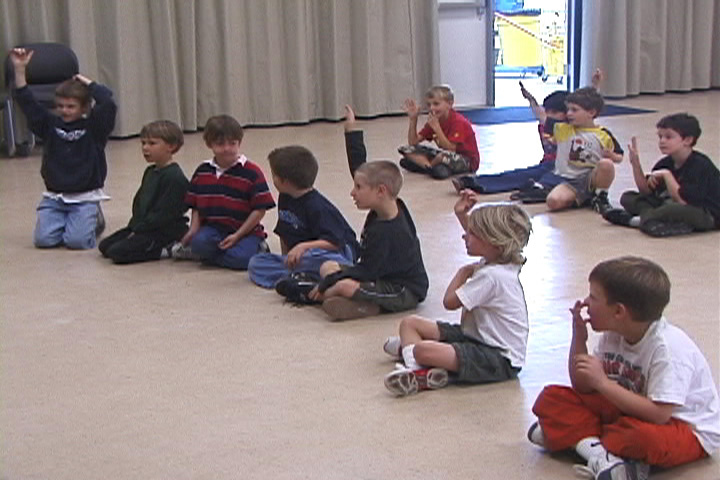
| Mood: | happy or sad, energetic or calm, cautious or impulsive, agitated or relaxed, excited or lazy, heroic or timid, grand or intimate, frightful or friendly, contemplative or extrovert, etc. |
| Gait: | hopping or crawling, walking or running, stomping or tiptoeing, dancing or marching, strolling or sneaking, etc. |
| Tempo: | casual or tense, dragging or rushing, hasty or lazy, lively or tired, playful or busy, etc. |
Children carry out their physical motion according to the prominent features in music. They move to such elements as beat, downbeat, melodic or rhythmic figures in a most spontaneous way.
EXAMPLE:
A swinging slow waltz rhythm suits an elongated stretching or swaying movement of the entire body. When music changes from swinging to sharp accents, it prompts a switch from stretching to energetic jumps.
In many instances, vocalization energizes children. It promotes a sense of unity between children within the group, which is especially valuable when a child is exercising to the video recording, all by himself.
Vocalizing also helps coordinate the body to the sound of music, syncing the physical motion within the group. In many exercises there is a particular word or syllable that is uttered in conjunction with the story.
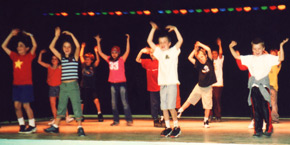
An important condition for the effectiveness of an MIS session is its group implementation. The best approach would be to have a group of 3 or more kids perform the exercise together following an instructor or peer leader.
For children at home, there is the option of playing back a video recording of a group session and moving together to the video. The psycho-physiological conditioning occurs optimally when it is accorded with visual priming. Learning a physical motion then occurs more spontaneously and contagiously.
For classroom sessions, we use a proprietary grading system where children's performance is measured by the number of motions successfully accomplished as well as with the quality of the execution of the motion. We keep track of the kids' grades, strengths, weaknesses, and their entire training history in their workout logs. For kids who get things quickly, we can easily ramp up their workout intensity with a variety of fitness equipment.
The structure of our exercises allows for a wide range of accessories such as:
- foam rollers
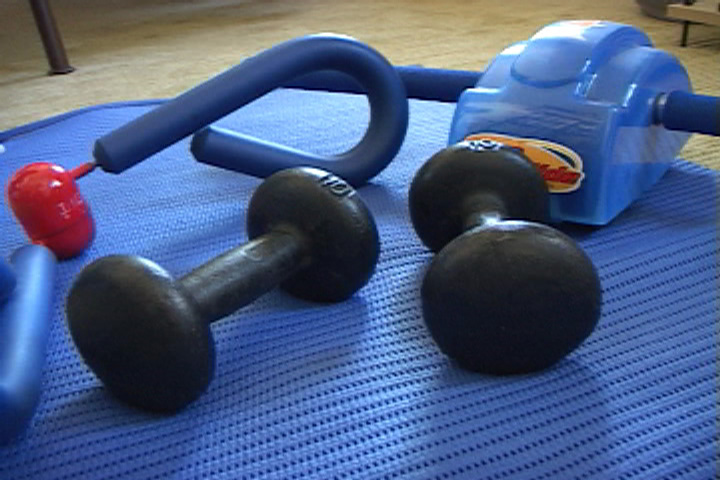
- half-swiss balls
- fitness bands
- jump-ropes
- dumbbells
- weight-vests
- ankle and wrist weights
- medicine balls
- weighted body bars
In our program, equity is not an obstacle for excellence.
If a child is engaged in a jump-rope oriented workout, and it becomes too easy for her, we can put a weight-vest on her to increase the difficulty.
If she is performing a dumbbell workout which becomes too easy, we just increase the intensity by giving her heavier dumbbells.
The best way for kids to become fit is for them to complete their workouts on a regular basis.
Sounds too good to be true? Not in Mozart in Shape!
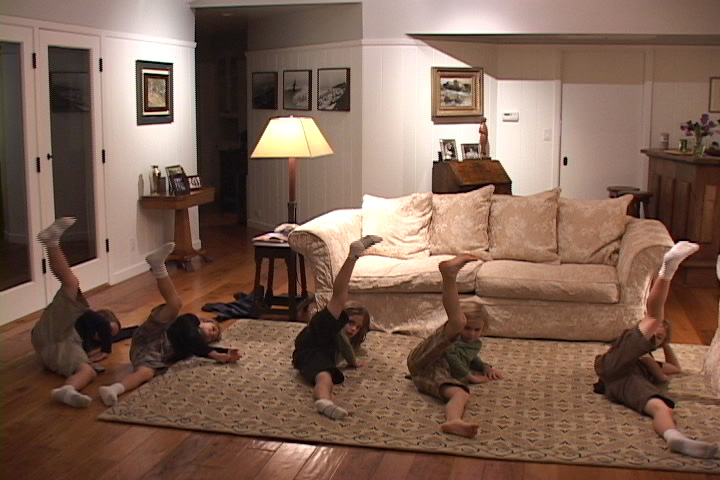
Our experience shows that children love the exercises so much that they repeat them at home, at parties and in the playgrounds. They often specifically ask for the CD with the music that we use in the classroom. Their parents report that it is exactly these CDs that their kids want to hear - whether they are driving somewhere in the car or getting ready for school in the morning.
Indeed, supplying a child with a CD or mp3's of Mozart In Shape music provides the easiest and the most effective assurance that the child will perform the exercises at home.
What makes our approach so unique and innovative is that it taps into children’s innate imaginative power and gift of synesthetic imagery perception.

- We select a set of physical exercises and invent a story to it that would be interesting for a given age-group of children.
- We project the story onto specific characteristic motions that constitute a pretend or imitation game.
- We then find a piece of music whose structure matches the structure of the movements in the exercise. Where necessary, we edit the recording of the music-piece or find an alternative performance, until such match becomes perfect.
- At this point, children perceive the fitness exercise as an exciting play-game.
As a result, children learn to do the exercises without even being aware of the fact that they are doing some hard work-out! They only want to repeat their favorite games over and over, thereby establishing a stable preference for physical exercise. Over time, this preference can eventually grow into a healthy habit of active life-style.
Classical music provides a means of reaching children across cultural barriers. This is due to classical music’s wealth of lexicon of expressions that was historically developed to provide a myriad of images and to invoke a wide gamut of emotional experiences.
For the past 400 years, classical composers have competed with each other in the free-market conditions to achieve the greatest impact on their audiences. As a result, Western music progressed into a state of highly entertaining theater, unparalleled by any other musical tradition.
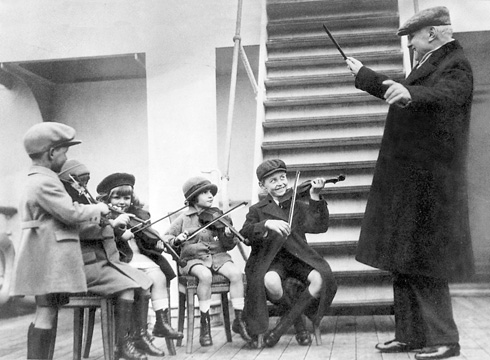
The spread of classical music across the globe, and its acceptance by all nations, give it a status-quo as an international language of emotional communication, underlying all ethnic, pop, folk and traditional types of music.
Drawing from the idioms of classical music allows us to engage children’s natural emotional responses, which are strong enough to consistently motivate them to play active games. The second part of the equation is turning physical exercises into characteristic and representational games, impersonations, acting, and imitations. Altogether, it is combining masterworks of classical music and fun activities that gives the magic formula for success.
Of all the wonderful musical traditions around the world, in our experience, the most effective means of stimulating game-play behavior in primary school-aged children has proved to be classical music.
 What's MIS?
What's MIS?





